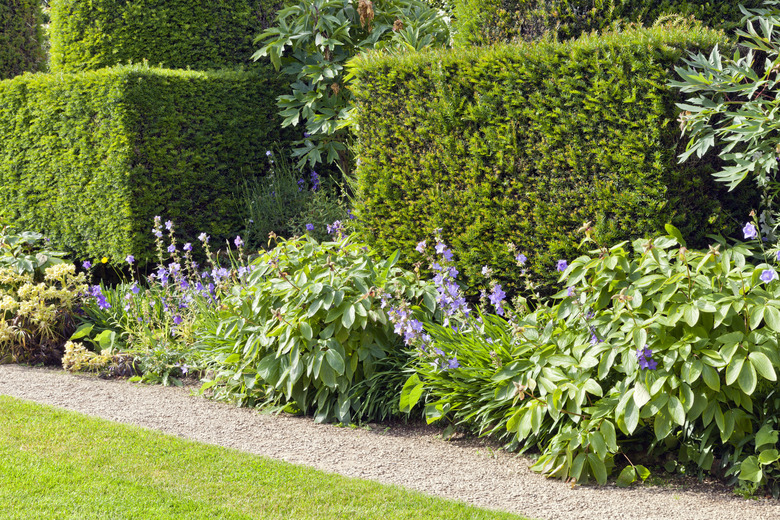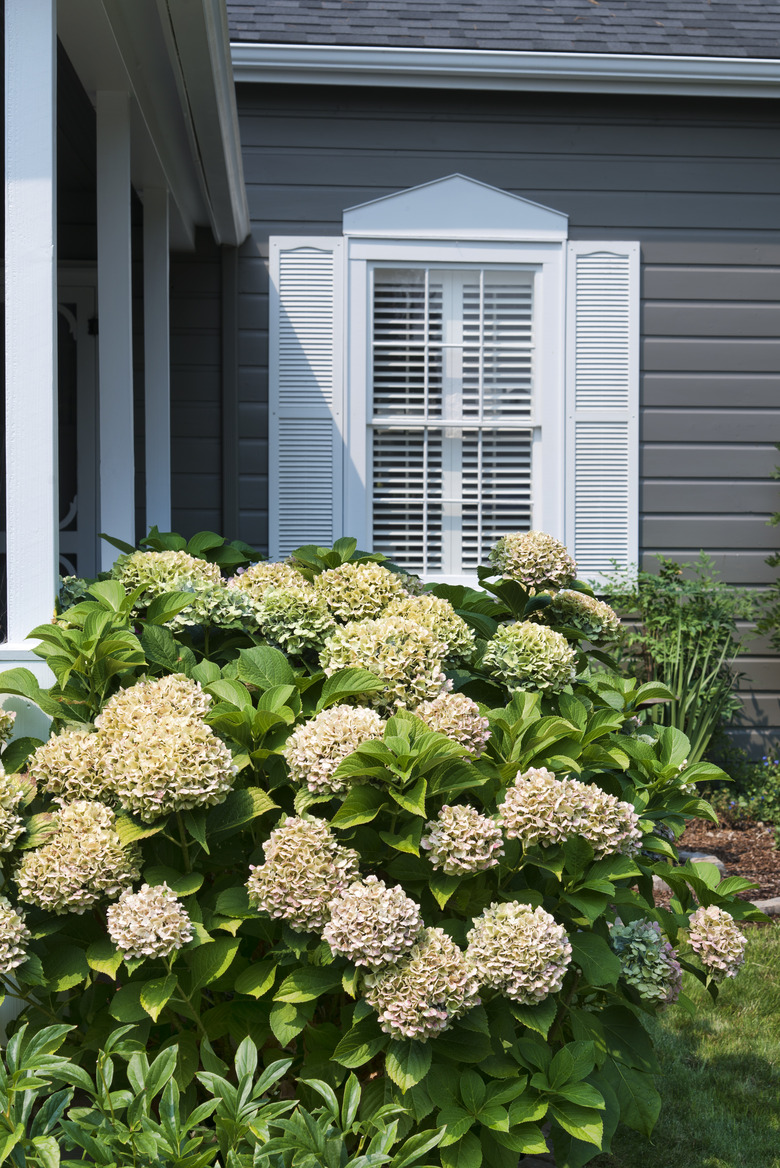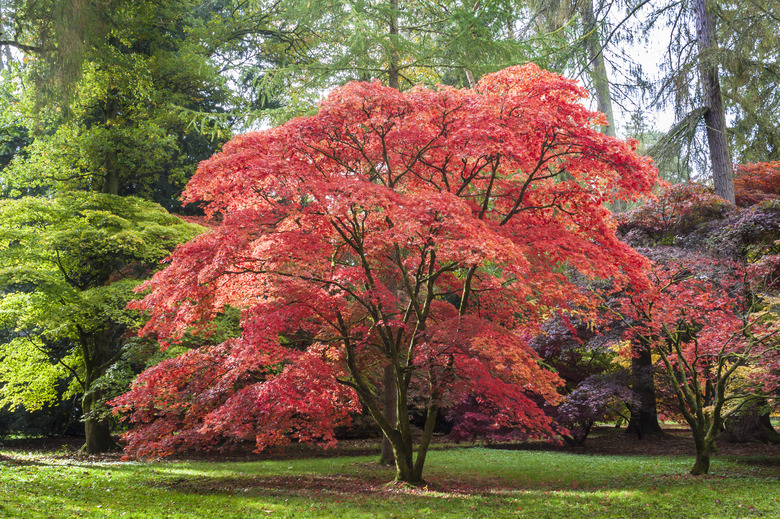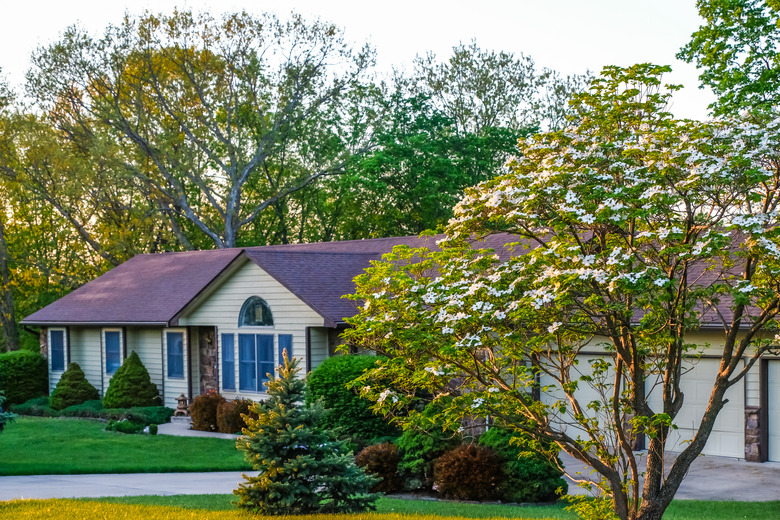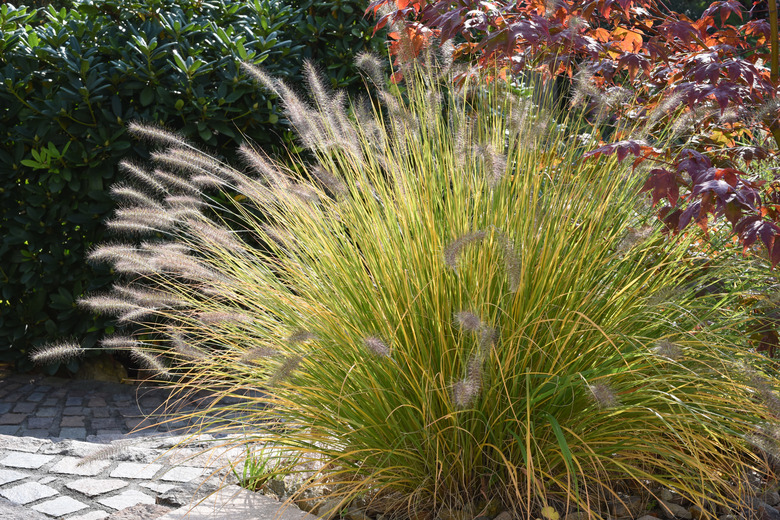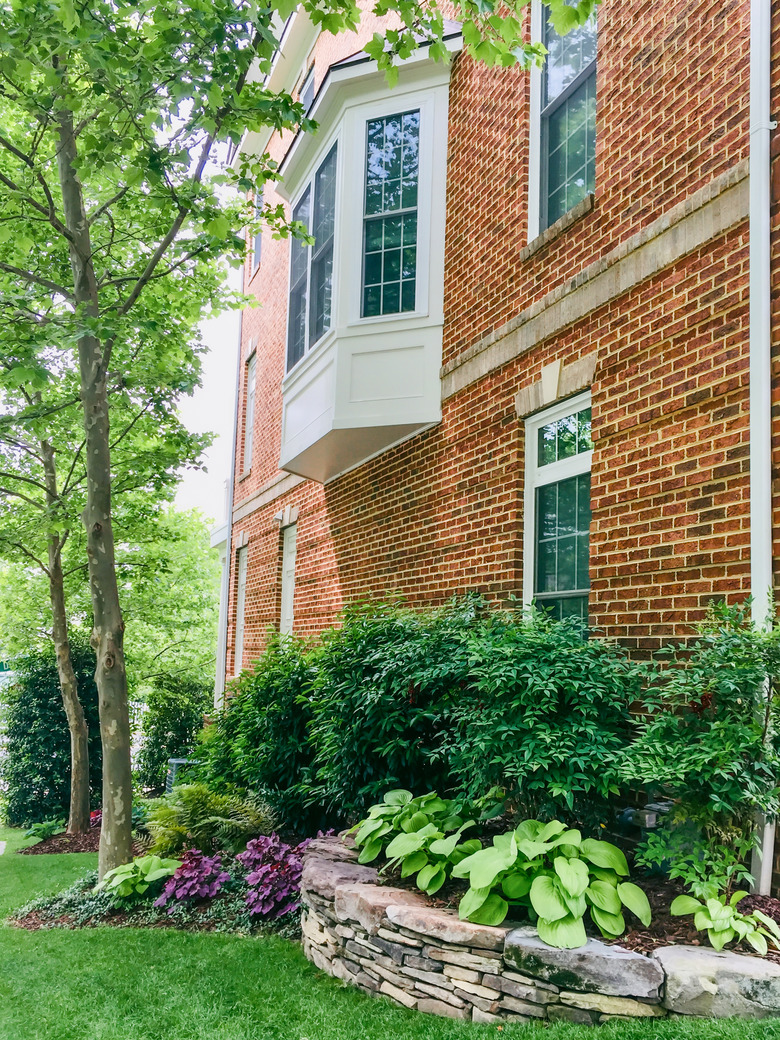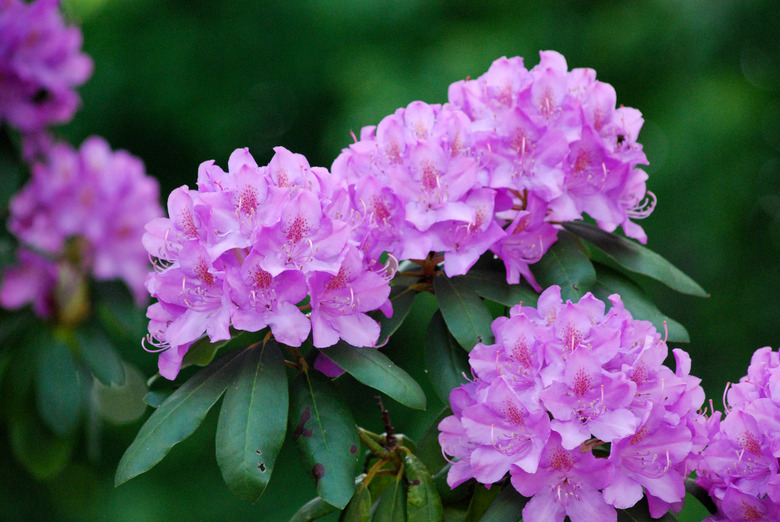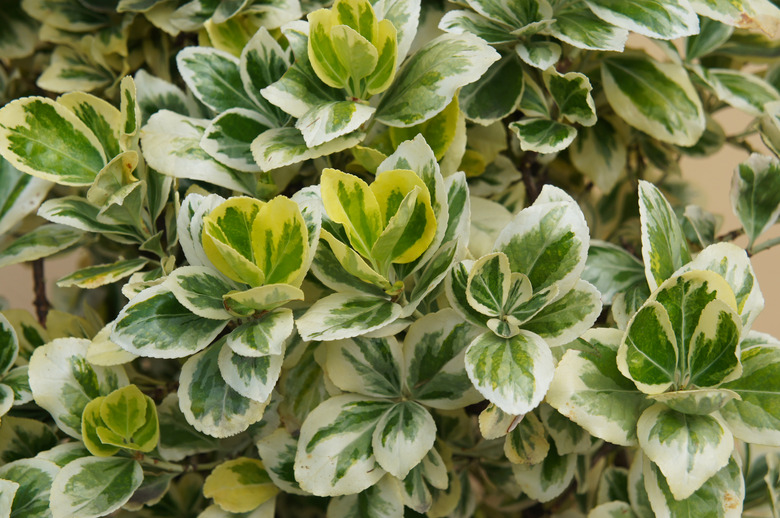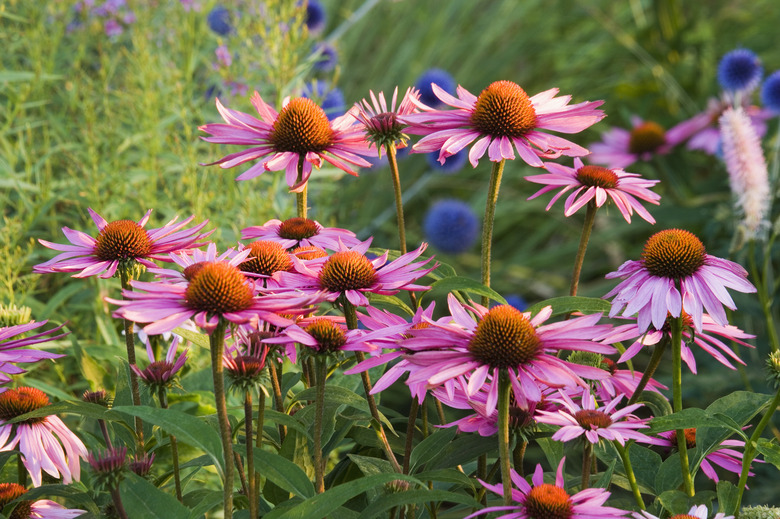10 Best Foundation Plantings For Shade
We may receive a commission on purchases made from links.
In landscape design, foundation plantings positioned against the house usually include easy-maintenance shrubs that serve to soften the visual transition between the horizontal planes of the yard and the vertical planes of the house. They can also hide utility features, such as air conditioner compressors or utility entrances, and they can improve a home's security by making it a bit harder for intruders to approach windows. Aesthetically, these shrubs are chosen with a variety of rounded, spreading and columnar shapes to help the home blend into the surrounding landscape.
Often, these foundation plantings must be highly tolerant of shady locations. The ground along the north side of a home is mostly shaded by the wall structure, and if the home happens to have wide roof overhangs or there are lots of shade trees on the property, all four sides of the foundation may be heavily shaded.
In recent years, the traditional strategy of using only a mixture of shrubs along the foundation has changed. As noted by Fine Gardening, today's trend is to design foundation plantings as mixed garden spaces. Foundation planting today is more likely to be a blend of specimen shrubs, perennial stalwarts, edging plants and even climbers.
Qualities of Good Foundation Shade Plants
Qualities of Good Foundation Shade Plants
Good choices for foundation plantings often share certain characteristics:
- Year-round interest: Foundation plantings are viewed quite directly by visitors approaching your home, so most of the foundation plants should offer some visual interest year-round. This is one reason evergreen shrubs have been so popular, but there are many deciduous shrubs and perennial plants that have year-round interest.
- Tolerance for dryness: The strip of yard around the home is often covered with wide roof overhangs and is thus naturally sheltered from rainfall. While irrigation systems can water this space, sprinkler heads rarely cover the entire space. Thus, the plants you choose should have a fairly good tolerance for dry conditions.
- Tolerance for poor soils: Because foundation plantings are often located between concrete foundations and strips of concrete or masonry walkways, the soil may gradually become somewhat alkaline from moisture leaching through the concrete. Further, the soil around homes is often filled with rubble and poor-quality backfill during construction. Unless the area around the home is amended with good-quality organic matter this area can be poor for growing plants. The best foundation plants will be forgiving of poor soils.
- Easy maintenance: Accessing the space around foundation plants to do trimming, deadheading and other gardening tasks can be awkward. The best plants will have minimal care and maintenance needs.
- Proper scale: A walk around any neighborhood to survey the foundation plantings will show how often the shrubs are mismatched for the scale of the home. Tall, columnar shrubs planted against low, ranch-style homes will look jarring in the same way that low, spreading shrubs look out of place when positioned against a peaked Tudor-style home. Make sure to choose plants with shapes and sizes that complement the home's architecture.
1. Yews
1. Yews
Yew (Taxus spp.) shrubs are a stalwart for foundation plantings and for good reason. These needled evergreens include species and cultivars of many shapes and sizes, from columnar uprights to low spreaders. Yews are also very tolerant of dry, shady locations, making them a perfect choice for foundation use.
Most yews used for foundation plantings are low spreaders, ideal for planting beneath windows. A great choice is the cultivar Taunton (Taxus x media 'Taunton'), which grows 3 to 4 feet tall with a 4- to 6-foot spread. Like most yews, it has dark-green flattened needles. It is a faster grower than many yews and is suitable for growing in United States Department of Agriculture (USDA) hardiness zones 4 through 8.
If you want a more upright, rounded yew, consider using Taxus x media 'Densiformis' (also suitable for growth in USDA hardiness zones 4 through 7), which grows to about 4 feet tall. Because yews are generally slow-growing, you can also use varieties that are very large when mature, keeping them pruned to the size you want. While most yews are very dark green, there are also varieties that have light, yellow-green needles.
2. Hydrangeas
2. Hydrangeas
Hydrangeas (Hydrangea spp.) have good reasons for being popular for foundations. They are one of the few flowering deciduous shrubs that do very well in shady locations. Depending on species and cultivar, hydrangeas are perennials in USDA zones 3 through 8. They have large leaves that create a somewhat coarse texture in the landscape and enormous flower clusters that will dry on the stems to create winter interest.
- Panicle hydrangea (Hydrangea paniculata) can grow 8 to 15 feet in the warmer end of the hardiness range (zones 3 through 8), but in colder climates, they may die back to the ground and can be grown as herbaceous perennials.
- Bigleaf hydrangea (Hydrangea macrophylla) is the classic hydrangea that changes flower color based on the soil pH — blue in acidic soils and pink in alkaline soils. Because soil conditions around foundations are usually high in lime, hydrangeas often bloom with pink flowers in these locations. Bigleaf hydrangeas are appropriate for growing in zones 5 through 11, depending on cultivar. They are generally about 4 to 10 feet in height.
- Oakleaf hydrangea (Hydrangea quercifolia) has lobed leaves resembling oak leaves, and it flowers with white blooms that gradually turn purplish-pink. Appropriate for zones 5 through 9, it grows 5 to 8 feet tall.
Because they are so popular, some people find hydrangeas to be a somewhat boring, predictable choice. If you want something new, consider planting a tree hydrangea. Tree hydrangeas are typically cultivars of H. paniculata ('Grandiflora' is one cultivar commonly sold as a tree hydrangea), but you can also train any panicle hydrangea into a small tree form by systematically removing all but one central stem.
3. Japanese Maple
3. Japanese Maple
Japanese maples (Acer palmatum) are traditionally a rather cold-sensitive specimen tree (zones 5 through 9), but a sheltered location along a foundation may allow you to cheat the zone requirements a little. Further, there are now a few Japanese maples rated for zone 4, and some might even survive in zone 3 when planted in a sheltered, shady location along a home foundation.
Japanese maples have delicate, toothed leaves that can range from pale yellow-green to a deep crimson burgundy, and they typically put on a great fall color display. These are deciduous trees that shed their leaves in winter, but the meandering pattern of the bare branches can create a stark geometry that provides winter interest. For foundation planting, choose a variety that grows 6 to 10 feet tall. Japanese maples may struggle a little in full-shade locations.
4. Dogwoods
4. Dogwoods
Dogwoods (Cornus spp.) are small trees or multistem deciduous shrubs that do well in partial-shade locations, and they tolerate deeper shade. Most species are naturally suited for zones 5 through 9, but there are also cultivars suitable as far north as zone 3 and as far south as zone 10.
Dogwoods are quite vigorous when planted in the confined spaces along foundations. Although these deciduous shrubs shed their leaves in winter, the red-twig dogwood (Cornus sericea, USDA zones 3-7) has attractive red twigs that add considerable winter interest. There are yellow-twig variations of C. sericea. Many varieties also produce small fruits that will interest birds.
Dogwoods are very low maintenance, will thrive in almost any location and tolerate occasional hard pruning to keep them under control. The most common dogwoods for foundation use grow 5 to 8 feet tall and will gradually spread to form small thickets. They are best suited where you seek a native look, and they readily pair with ornamental grasses and other meadow plants.
5. Ornamental Grasses
5. Ornamental Grasses
Ornamental grasses are a good choice for foundation plantings where you want to add different texture or if you seek a native-garden look. Left to dry out, the waving stalks add interesting winter appeal in colder climates. Grasses are not a traditional foundation plant, but they are increasingly popular as foundation gardens become more diverse.
- Fountain grass: Fountain grass (Pennisetum alopecuroides, USDA zones 6-9) is a perennial grass that grows 2 1/2 to 5 feet tall with clumps of wavy blades that add tremendous texture to foundation plantings. It does well in part shade.
- Japanese forest grass: Preferring part shade in the northern end of its range and close to full shade in hot climates, Japanese forest grass (Hakonechloa macra, USDA zones 5-9) is an ideal foundation grass. Growing 12 to 18 inches tall, some cultivars have variegated foliage.
- Tufted hair grass: This clumping perennial grass (Deschampsia cespitosa, USDA zones 4-9) grows 2 to 3 feet tall. It forms mounds of very thin, dark-green grass blades. It is one of the few ornamental grasses that grows very well in full shade.
6. Hostas
6. Hostas
While sometimes scorned as being too common, hostas (Hosta spp., USDA zones 3-8 depending on species and cultivar) remain an unsurpassed choice for foundation plantings since they are very low maintenance and come in an enormous range of varieties, from enormous leaves of ruffled blue-gray ('Elegans') standing 2 or 3 feet tall to varieties with tiny, delicate leaves ('Mouse Ears') that are well-suited as a front edging plant. These are deciduous perennials, however, so they will always die back in cold winters. In these climates, they are best used as fillers around larger plants with year-round interest.
Hostas are one of the most maintenance-free of all perennial plants. They are grown mostly for their foliage, but since there are so many different textures, sizes and shades of leaf color available, hostas offer great diversity in garden design.
7. Rhododendrons
7. Rhododendrons
Rhododendrons and azaleas (Rhododendron spp., USDA zones 2-10, depending on species and cultivar) are highly prized for their spectacular spring flowers, and they are one of the few spring-flowering shrubs that does very well in shady locations. The spectacle of spring blooms is unparalleled, but be aware that they typically lose their appeal after the flowers fade. In summer, rhododendrons become a rather bland, sparse shrub, and fall color is minimal.
Thus, it is best to use rhododendrons in conjunction with other plants that compensate once their blooms fade. Rhododendrons are a somewhat better choice than azaleas since many species have leathery evergreen leaves that remain in place through winter in all but the coldest climates.
There are rhododendron varieties for nearly every climate zone, from 2 through 10. These multistemmed shrubs are available in smaller varieties that grow 2 to 3 feet high as well as large varieties that approach small tree stature, especially in the South.
8. Boxwoods
8. Boxwoods
Boxwood (Buxus spp., USDA zones 4-10, depending on species and cultivar) is a dense, multistemmed shrub. It is a broadleaf evergreen that is often used as a hedge but also makes an excellent edging plant for foundation areas planted with mixed shrubs. Boxwood has a dense growth structure that is almost impenetrable, and it thrives under regular hard pruning where a formal look is required.
Various species and cultivars of boxwood are available, ranging from 1 to 6 feet tall. Most are quite tolerant of part shade. Korean boxwood (Buxus sinica var. insularis) is one of the most cold-hardy boxwood selections, suitable as a perennial in USDA zones 4 through 9.
9. Wintercreeper
9. Wintercreeper
With the new emphasis on making foundation planting areas diverse beds with a mixture of plant types, it only makes sense to include climbing perennials for vertical interest. The foundation areas against the house wall can be some of the driest and shadiest of all locations, though, so there aren't many plants that fit the bill. It's best to choose plants that twine onto a trellis rather than plants that cling to the siding of the home, which can cause damage.
One climber that fits the requirements is wintercreeper (Euonymus fortunei, USDA zones 4-9, depending on cultivar), a trailing perennial that can serve as ground cover and as a shrub and that also readily climbs if given a trellis against the wall. It has a good tolerance for relatively dry conditions and does well in part shade. 'Coloratus' is a particularly good cultivar, cold-hardy to zone 4. In winter, the green foliage of this semievergreen turns dark purple. With many varieties topping out at about 9 feet, this is a climber that is fairly easy to control.
10. Coneflowers
10. Coneflowers
Various species and cultivars of coneflower (Echinachea spp., USDA zones 3-10, depending on species and cultivar) can work quite well as foundation plants. Although they are more traditionally used in sunny locations, they can do well in part shade. While these herbacious perennials die back in winter, the flower heads can be left to dry in place, serving as a lure for birds who feast on the seeds. Traditionally, coneflowers have pinkish-purple, daisy-like flowers with darker centers, but there are now many cultivars featuring a range of colors, including whites, oranges and yellows.
Coneflowers are easy-care plants that bloom from midsummer well into late fall. They typically grow 12 to 24 inches tall. There are several other daisy-like flowers that can also work in part-shade foundation locations, such as the various Rudbeckia species (brown-eyed Susan [Rudbeckia triloba, USDA zones 4-8] and black-eyed Susan [Rudbeckia hirta, USDA zones 3-7]). However, these will not do well in deeper shade. Another daisy that will flower in part shade is Shasta daisy (Leucanthemum x superbum, USDA zones 4-9).

